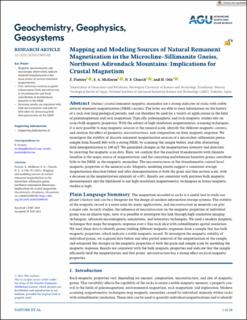| dc.contributor.author | Pastore, Zeudia | |
| dc.contributor.author | McEnroe, Suzanne | |
| dc.contributor.author | Church, Nathan Stewart | |
| dc.contributor.author | Oda, Hirokuni | |
| dc.date.accessioned | 2021-04-15T07:59:06Z | |
| dc.date.available | 2021-04-15T07:59:06Z | |
| dc.date.created | 2021-02-11T09:15:16Z | |
| dc.date.issued | 2021 | |
| dc.identifier.citation | Geochemistry Geophysics Geosystems. 2021, 22 (3), . | en_US |
| dc.identifier.issn | 1525-2027 | |
| dc.identifier.uri | https://hdl.handle.net/11250/2737853 | |
| dc.description.abstract | Distinct crustal remanent magnetic anomalies are a strong indicator of rocks with stable natural remanent magnetization (NRM) carriers. The latter are able to store information on the history of a rock over long geological periods, and can therefore be used for a variety of applications in the field of paleomagnetism and rock magnetism. Typically, paleomagnetic and rock‐magnetic studies rely on rocks bulk magnetic properties. With the advent of high‐resolution magnetometric scanning techniques, it is now possible to map magnetic sources at the mineral scale, identify the different magnetic carriers, and analyze the effect of geometry, microstructures, and composition on their magnetic response. We investigate the stability of discrete remanent magnetization sources of a microcline–sillimanite gneiss sample from Russell Belt with a strong NRM, by scanning the sample before, and after alternating field demagnetization to 100 mT. We quantified changes in the magnetization intensity and direction by inverting the magnetic scan data. Here, we confirm that the exsolved titanohematite with ilmenite lamellae is the major source of magnetization, and the coexisting multidomain hematite grains contribute little to the NRM, or the magnetic anomalies. The microstructures in the titanohematite control local magnetic properties at the mineral scale. Magnetic modeling results suggest a consistent average magnetization direction before and after demagnetization at both the grain and thin section scale, with a decrease in the magnetization intensity of ≈30%. Results are consistent with previous bulk magnetic measurements and the likelihood to use high‐resolution magnetometric techniques in future magnetic studies is high. | en_US |
| dc.language.iso | eng | en_US |
| dc.publisher | AGU, American Geophysical Union and Wiley | en_US |
| dc.rights | Navngivelse 4.0 Internasjonal | * |
| dc.rights.uri | http://creativecommons.org/licenses/by/4.0/deed.no | * |
| dc.title | Mapping and modelling mineral sources of natural remanent magnetization from the Russell Belt microcline-sillimanite gneiss, Northwest Adirondack Mountains, USA | en_US |
| dc.type | Peer reviewed | en_US |
| dc.type | Journal article | en_US |
| dc.description.version | publishedVersion | en_US |
| dc.source.volume | 22 | en_US |
| dc.source.journal | Geochemistry Geophysics Geosystems | en_US |
| dc.source.issue | 3 | en_US |
| dc.identifier.doi | https://doi.org/10.1029/2020GC009580 | |
| dc.identifier.cristin | 1888730 | |
| dc.description.localcode | © 2021. The Authors. This is an open access article under the terms of the Creative Commons Attribution License, which permits use, distribution and reproduction in any medium, provided the original work is properly cited. | en_US |
| cristin.ispublished | true | |
| cristin.fulltext | original | |
| cristin.qualitycode | 2 | |

